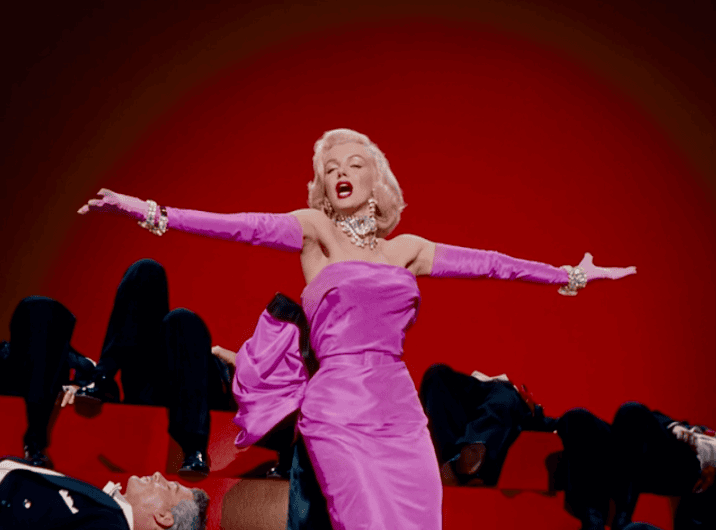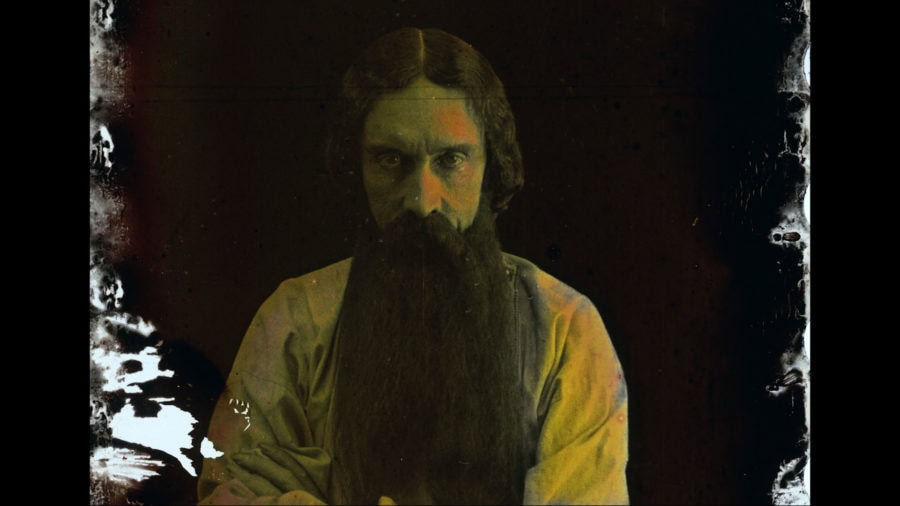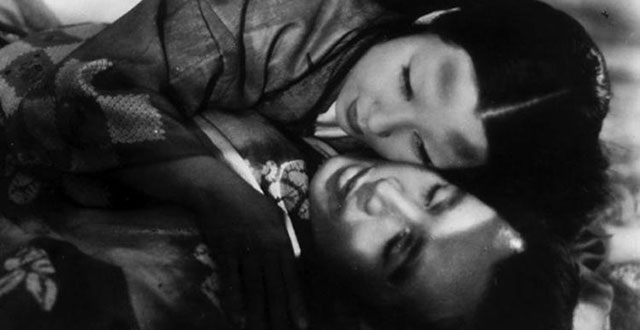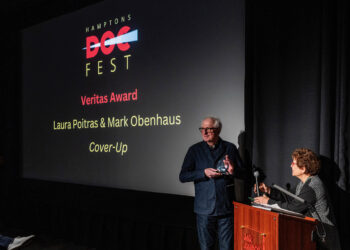The Sag Harbor Cinema announces the full list of programs and guests for the first edition of The Sag Harbor Cinema Festival of Preservation. The festival, taking place November 19-22, will emphasize the importance of preserving film and its culture, as well as create an opportunity for the community to connect with an esteemed group of experts in the field.
The program will feature a varied selection of beautifully restored films, spanning from one of Ernst Lubitsch’s early masterpieces (Forbidden Paradise), to a Classic of the Golden Age of Mexican to Cinema (Enamorada); from Marlon Brando’s only directorial effort (the western in VistaVision, One Eyed Jacks), to the explosive glamour of Marylin Monroe and Jane Russell (Gentlemen Prefer Blondes) to Melvin Van Peebles’ incendiary Sweet Sweetback Baadasssss Song.
The ambitious series will also feature the sublime Technicolor of Michael Powell’s The Red Shoes (a Martin Scorsese favorite) and the electric black and white of Night Of the Living Dead, directed by George Romero (also a great Michael Powell fan). Celebrated filmmaker Bill Morrison will come and introduce his latest poetic journey in disintegrating celluloid, The Village Detective: A Song Cycle.
Film Forum’s director of repertory programming and founder of Rialto Pictures, Bruce Goldstein, will bring his widely acclaimed Nicholas Brothers presentation to Sag Harbor Cinema, while Joe Lauro, of the East End’s own Historic Films Archive will show rare footage from his collection. Margaret Bodde, executive director of The Film Foundation, will be at hand to discuss the culture and the movement for preservation nurtured by Martin Scorsese’s organization, and Cineric Laboratories’ founder, Balasz Nayari, will share insights on the process of restoration.
“Cultivating the culture and the experience of film is an essential part of Sag Harbor Cinema’s DNA. It seemed only natural that we would want to create an opportunity for our audience to connect more intimately with the world of film preservation through an annual program that combines great films with the insight provided by the people that make it possible for film history — and the movies we love — to remain alive, available, and relevant to our present. Especially for this first edition, I wanted a lineup that would reflect the richness and vibrancy of cinema across different decades, styles and textures, ” says Founding Artistic Director, Giulia D’Agnolo Vallan.

ENAMORADA
Dir. Emilio Fernández
Mexico, 1946; 99 mins, in Spanish with English subtitles
This wildly passionate and visually beautiful love story from director Emilio Fernández and cinematographer Gabriel Figueroa, a follow-up to their extraordinarily successful María Candelaria, remains one of the most popular Mexican films ever made. As critic Farran Smith Nehme wrote, it was “one of the biggest hits of Fernández’s career and a high-water mark for nearly everyone involved.” The romance between between a revolutionary General (Pedro Armendáriz) and the daughter of a nobleman (Maria Félix) set during the Mexican revolution (in which Fernández himself fought) was inspired by The Taming of the Shrew and, for the finale, by the end of Sternberg’s Morocco.

Directed by Ernst Lubitsch
Shown from left: Rod La Rocque, Pola Negri
FORBIDDEN PARADISE
Dir. Ernst Lubitsch
USA, 1924; 73 mins
As they fill major gaps in our appreciation of Ernst Lubitsch’s silent-era career in Hollywood, we rejoice in the Museum of Modern Art’s painstaking restoration, supported by The Film Foundation, of Forbidden Paradise (1924), Lubitsch’s only American film with Pola Negri, in its most complete version in nearly 100 years. A delightfully ahistorical costume melodrama about the erotic seductions and lonely deprivations of Empress Catherine the Great, Forbidden Paradise reveals itself to be what MoMA curator Dave Kehr calls “the first fully achieved film of Lubitsch’s mature period,” graced as it is with the comic touches and sophisticated rhythmic compositions for which Lubitsch would become legendary.

GENTLEMEN PREFER BLONDES
Dir. Howard Hawks
USA, 1953; 91 mins, in English
Bachelorette showgirl singers Dorothy Shaw and Lorelei Lee are sailing to Paris, courtesy of Lorelei’s millionaire boyfriend, Gus Esmond, Jr. The best friends both have the ambition to secure an engagement ring, but hold different standards for potential suitors. With a manipulative detective hot on their trail, Jane Russell and Marilyn Monroe give dazzling performances as they dance, sing, and strut their way through Howard Hawks’ classic adaptation of the stage musical based on Anita Loos’s novel.

NIGHT OF THE LIVING DEAD
Dir. George Romero
USA, 1968; 96 mins, in English
A deceptively simple tale of a group of strangers trapped in a farmhouse who find themselves fending off a horde of flesh-eating ghouls newly arisen from their graves, Romero’s claustrophobic vision of a late-Sixties America (literally) tearing itself apart rewrote the rules of the horror genre, combined gruesome gore with acute social commentary, and quietly broke ground by casting a Black actor (Duane Jones) in the lead role. After decades of poor-quality prints and video transfers, Night of the Living Dead can finally be seen for the immaculately crafted film that it is thanks to a new 4K restoration, scanned from the original camera negative and supervised by Romero himself. Stark, haunting, and more relevant than ever, Night of the Living Dead is back.

ONE-EYED JACKS
Dir. Marlon Brando
USA, 1961; 141 mins, in English
The only film directed by Marlon Brando is a western like no other, combining the mythological scope of that most American of genres with the searing naturalism of a performance by Brando, capturing a rugged coastal and desert landscapes in gorgeous widescreen; Technicolor images; and eliciting from his fellow actors (including Karl Malden and Pina Pellicer) nuanced depictions of conflicted characters. Based on an adaptation of Charles Neider’s novel (inspired by the life of Billy the Kid), the film is the last that Paramount shot in VistaVision. Though the production was overwhelmed by its director’s perfectionism and plagued by setbacks and studio reediting, One-Eyed Jacks stands as one of Brando’s great achievements, thanks above all to his tortured turn as Rio, a bank robber bent on revenge against his former partner in crime. Brooding and romantic, Rio is the last and perhaps the most tender of the iconic outsiders that the great actor imbued with such intensity throughout his career.

SWEET SWEETBACK’S BAADASSSSS SONG
Dir. Melvin Van Peebles
USA, 1971; 97 mins, in English
In Melvin Van Peebles’ second film, which he made after rejecting offers from Columbia to retain creative rights, he fills the role of producer, director, writer, composer, editor, and star. Sweet Sweetback gave Hollywood the prototype that would eventually become the blaxploitation hero. Revolutionizing Black and American independent cinema, Sweet Sweetback’s Baadasssss Song presents incendiary politics and a distinctive style, in which jagged jump cuts, kaleidoscopic superimpositions, and psychedelic sound design come together in a sustained howl of rage and defiance.

THE RED SHOES
Dirs. Michael Powell and Emeric Pressburger
UK, 1948; 135 mins, in English
“I’ve said and written so much about this picture over the years; for me it’s always been one of the very greatest ever made, and every time I go back to look at it—about once a year—it’s new: it reveals another side, another level, and it goes deeper. What is it that’s so special about The Red Shoes? Of course, it’s beautiful, one of the most beautiful Technicolor films ever made; it has such an extraordinary sense of magic—look again at the scene where Moira Shearer is walking up the steps to Anton Walbrook’s villa, especially in the new restoration: it seems like she’s floating on currents of sparkling light and air. And there’s no other picture that dramatizes and visualizes the overwhelming obsession of art, the way it can take over your life. But on a deeper level, in the movement and energy of the filmmaking itself, is a deep and abiding love of art, a belief in art as a genuinely transcendent state.” – Martin Scorsese (courtesy of The Criterion Collection)

THE VILLAGE DETECTIVE: A SONG CYCLE
Dir. Bill Morrison
USA, 2021; 81 mins, in English
During the summer of 2016, a fishing boat off the shores of Iceland made a most curious catch: four reels of 35mm film, seemingly of Soviet provenance. Unlike the film find explored in Bill Morrison’s Dawson City: Frozen Time, it turned out this discovery wasn’t a lost work of major importance, but an incomplete print of a popular comedy starring beloved Russian actor Mihail Žarov. Does that mean it has no value? Morrison thought not. To him, the heavily water-damaged print, and the way it surfaced, could be seen as a fitting reflection on the life of Žarov, who loved this role so much that he even co-directed a sequel to it. Morrison uses the story as a jumping off point for his latest meditation on cinema’s past, offering a journey into Soviet history and film accompanied by a gorgeous score by Pulitzer and Grammy-winning composer David Lang.

UGETSU
Dir. Kenji Mizoguchi
Japan, 1953; 97 mins, in Japanese with English subtitles
“Mizoguchi is one of the greatest masters who ever worked in the medium of film; he’s right up there with Renoir and Murnau and Ford, and after the war he made three pictures—The Life of Oharu, Ugetsu, and Sansho the Bailiff—that stand at the summit of cinema. All of his artistry is channeled into the most extraordinary simplicity. You’re face-to-face with something mysterious, tragically inevitable, and then, in the end, peacefully removed. I love all three of these pictures and many other Mizoguchi films as well (including Princess Yang Kwei-fei, The Story of the Last Chrysanthemums, and Miss Oyu, to name only a few), but Ugetsu has the most powerful effect on me. There are moments in the picture, famous ones, that I’ve seen again and again and that always take my breath away: the boat slowly materializing from out of the mist and coming toward us . . . Genjuro collapsing on the grass in ecstasy and being smothered by Lady Wakasa . . . the final crane up from the son making an offering at his mother’s grave to the fields beyond. Just to think of these moments now fills me with awe and wonder.” – Martin Scorsese (Courtesy of the Criterion Collection)

THE FABULOUS NICHOLAS BROTHERS, WITH BRUCE GOLDSTEIN
Fayard Nicholas (1914—2006) and Harold Nicholas (1921—2000) were two of the 20th century’s greatest dancers. These self-taught African American brothers were still kids when they headlined at Harlem’s famed Cotton Club, later conquering Broadway and Hollywood—and eventually achieving international stardom—in a career that spanned eight decades. But Hollywood limited their appearances to only one show stopping number in each of their movies (Astaire called their Stormy Weather routine the greatest dance number ever filmed) — they were never given lines to speak or a romantic interest, despite their success on Broadway as actors and comedians. A friend of the Brothers, Bruce Goldstein, Film Forum’s director of repertory programming since 1986 and founder of Rialto Pictures in 1998, was the writer and co-producer of an award-winning 1992 documentary on the team. In his acclaimed presentation on the dance team Goldstein utilizes rare personal and performance footage, recordings, and vintage photographs, along with his never-before-seen 1991 interviews with the brothers and other legends, including Cab Calloway, Max Roach, Bobby Short, Leonard Reed, and Gregory and Maurice Hines. This is as much about a tight-knit African American family, and the love between two brothers, as it is about two of the 20th century’s greatest artists. Special thanks to Rigmor Newman Nicholas.
FROM THE HISTORIC FILMS ARCHIVE – WITH JOE LAURO
Since 1991 Sag Harbor resident Joe Lauro’s HISTORIC FILMS ARCHIVE has provided historical film footage and vintage musical performance footage to countless feature films, museum exhibits and television programs. This presentation will include excerpts from several recently preserved films and televisions programs which are housed at Historic Films – such as recently discovered footage of the 1915 East Hampton 4th of July Parade, noted photographer Amalie Rothschild “student films” shot at Bill Graham’s legendary Fillmore East and the now vanished Chicago Maxwell Street Market as vividly captured by Michael Shea in And this Is Free.
For further information, tickets and the full calendar of events go to sagharborcinema.org.












